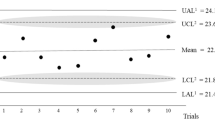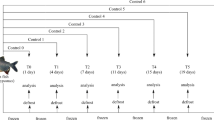Abstract
The detection of central nervous system (CNS) tissue (i.e. brain and spinal cord) by the use of GC-MS and certain fatty acids (FAs) as their methyl esters (FAMEs) was previously shown to be a very promising approach towards identification of CNS tissue as a specified risk material (SRM) in meat products, contrasting available immunochemical methods. This GC-MS method promised to allow quantification of CNS material as low as 0.01%. Here, we show that the CNS-relevant FAMEs C22:6, C24:1ω9, C24:1ω7, C24:0 and C24-OH are present in pure muscle and adipose tissue samples in detectable amounts. Thus, limits of detection are not feasible as quality parameters in this analytical GC-MS approach. Instead, cut-off values have to be applied as calculated from the baseline content of the respective FAME in CNS-free samples and its variation for a given statistical security. Furthermore, the FAs used for quantification of the CNS showed distinct differences depending on species and age. This finding is in accordance with previous studies where it had been concluded that species and age differentiation of CNS might be possible with GC-MS. However, it was not taken into account that it also necessitates a strict analytical strategy for quantification of the CNS content: identification of the presence of CNS (step 1); identification of species and age (step 2); and quantification by use of a species- and age-specific CNS calibration (step 3). Differences between the FA content of the CNS used for calibrating and the CNS in the sample will cause up to fivefold deviation from the true CNS content. Our results show that the FA best suited for identification (step 1) and quantification (step 3) purposes is cerebronic acid C24-OH after silylation. Further in-depth studies are needed in order to elucidate variability of brain FA content and to determine analytical limits. However, the present GC-MS approach is already a highly promising supplement to existing immunochemical methods for the detection of traces of CNS material in meat products.

Similar content being viewed by others
References
European Commission (2001) EC directive 2001/101. Off J L 310:19–21 http://europa.eu.int/eur-lex/pri/en/oj/dat/2001/I_310/I_31020011128en00190021.pdf
Will RG, Ironside JW, Zeidler M, Cousens SN, Estibeiro K, Alperovitch A, Poser S, Pocchiari M, Hoffmann A (1996) Lancet 347:921–925
European Commission (1999) Opinion of the scientific steering committee on the human exposure risk via food with respect to BSE, adopted on 10 December 1999 http://europa.eu.int/comm/food/fs/sc/ssc/out67_en.pdf
European Commission (2001) EC regulation 999/2001. Off J L 14:1–40 http://europa.eu.int/eur-lex/pri/en/oj/dat/2001/I_147/I_14720010531en00010040.pdf
Lücker E, Eigenbrodt E, Wenisch S, Leiser R, Bülte M (1999) J Food Prot 62:268–276
Lücker E, Eigenbrodt E, Wenisch S, Leiser R, Bülte M (2000) J Food Prot 63:258–263
Schmidt GR, Hossner KL, Yemm RS, Gould DH, O’Callaghan JP (1999) J Food Prot 62:394–397
Agazzi ME, Barrero Moreno J, von Holst C, Lücker E, Anklam E (2004) Food Control 15:297–301
Niederer M, Bollhalder R (2001) Mitt Lebensm Hyg 92:133–144
Biedermann W, Lücker E, Hensel A (2002) Berl Münch Tierärztl Wschr 115:131–134
Biedermann W, Lücker E, Poerschmann J, Lachhab S, Truyen U, Hensel A (2004) Anal Bioanal Chem 379:1031–1038, http://www.springeronline.com
Noti A, Biedermann-Brehm S, Biedermann M, Grob K (2002) Mitt Lebensm Hyg 93:387–401
Lücker E, Biedermann W, Lachhab S, Hensel A (2002) Fleischwirtschaft 82:123–128
Lachhab S, Biedermann W, Lücker E, Hensel A (2003) In: Proceedings of DVG 24–27 September 2002. Garmisch-Partenkirchen ISBN 3-936815-59-3, pp 502–507
Barcarolo R, Bau A, Barrero Moreno J, Dimitrova J, Anklam E (2003) J Sep Sci 26:1347–1352
MacNaughton SJ, Stephen JR, Venosa AD, Davis GA, Chang YJ, White DC (1999) Appl Environ Microbiol 65:3566–3574 http://www.ncbi.nha.nih.gov/entrez/query.fcgi?cmd=Retrieve&db=pubmed&dopt=Abstract&list_uids=10427050
Acknowledgements
This study was financially supported by the German Federal Ministry of Consumer Protection, Food and Agriculture.
Author information
Authors and Affiliations
Corresponding author
Rights and permissions
About this article
Cite this article
Lücker, E., Biedermann, W., Lachhab, S. et al. GC-MS detection of central nervous tissues as TSE risk material in meat products: analytical quality and strategy. Anal Bioanal Chem 380, 866–870 (2004). https://doi.org/10.1007/s00216-004-2845-1
Received:
Revised:
Accepted:
Published:
Issue Date:
DOI: https://doi.org/10.1007/s00216-004-2845-1




